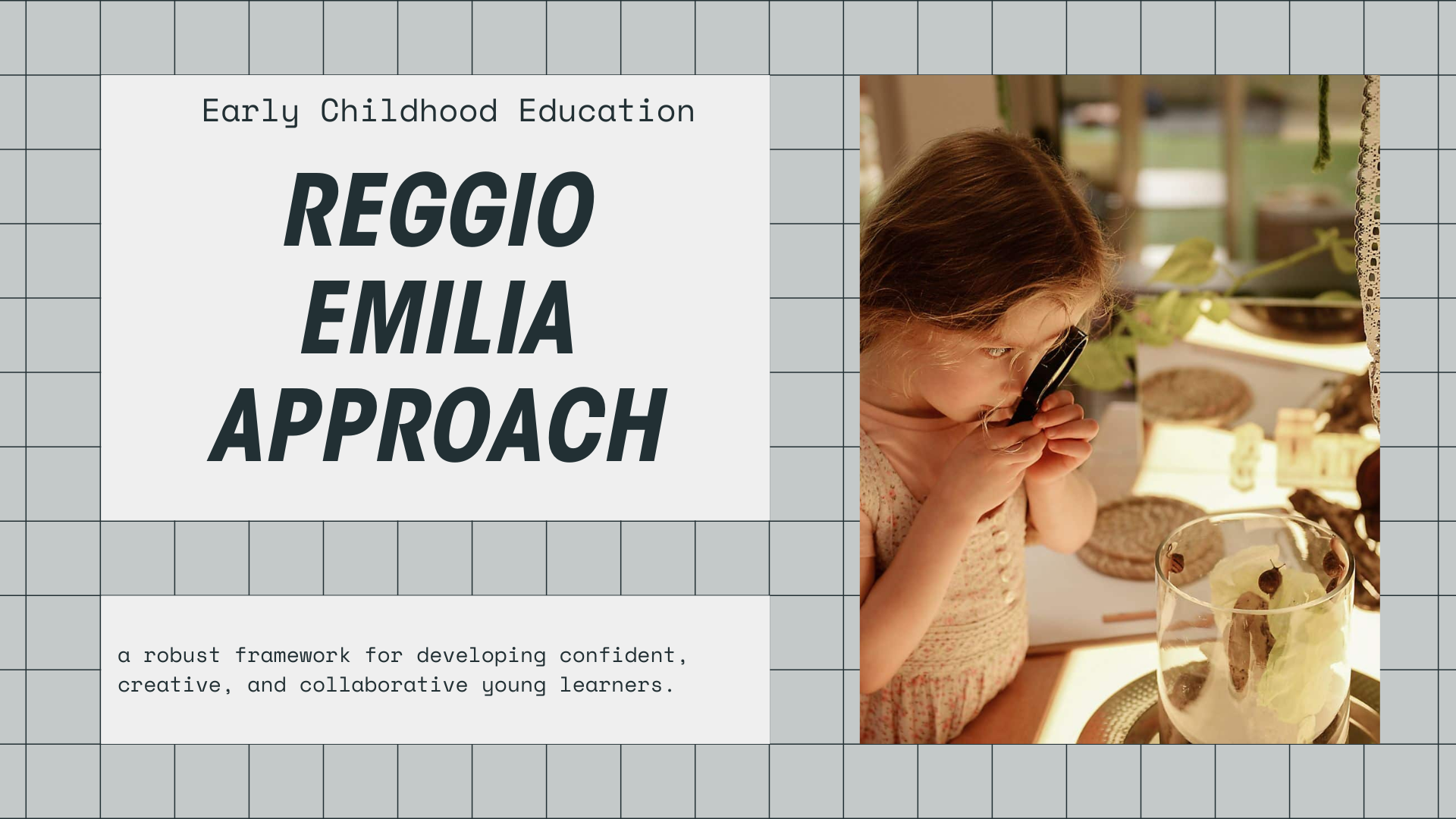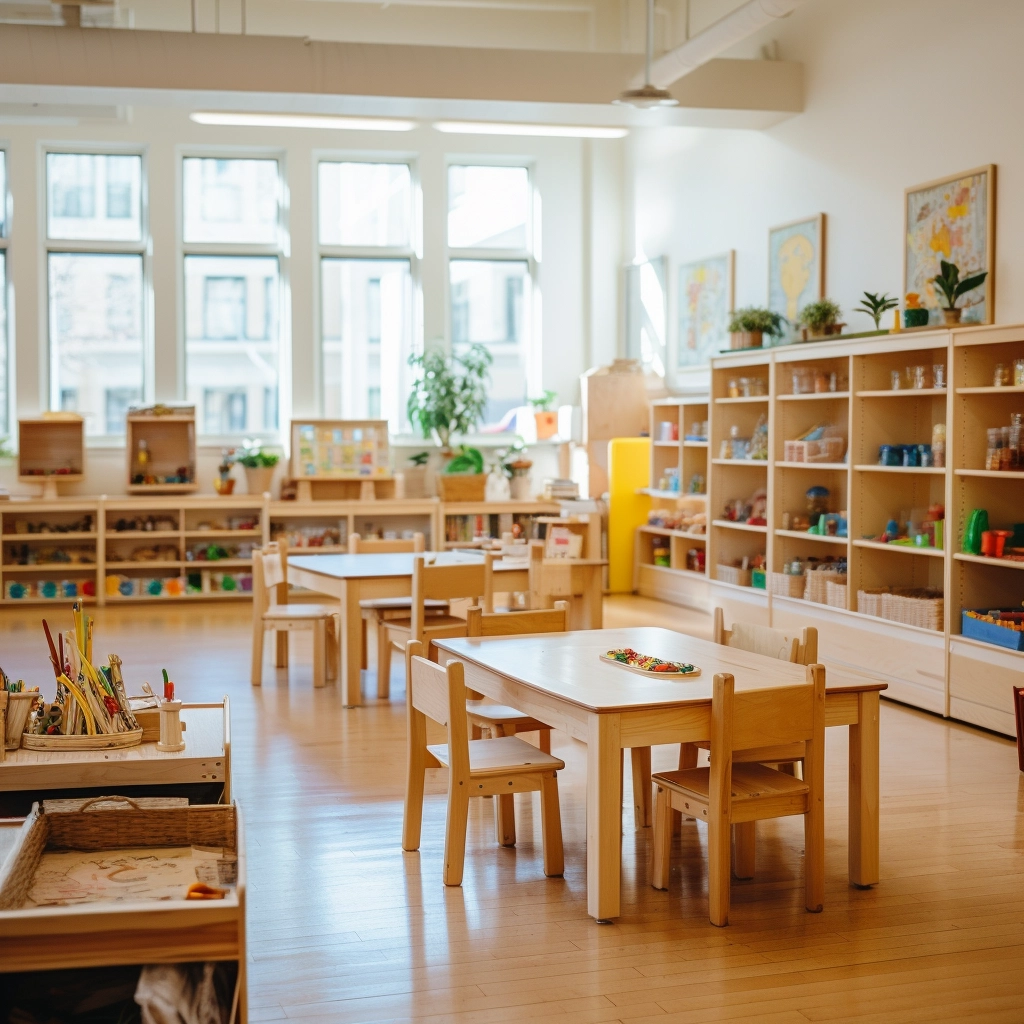Are you frustrated with early education models that treat children as passive recipients of knowledge? Do you feel that traditional classrooms are too structured, too uniform, and not conducive to genuine curiosity? Why do some kindergartens raise innovative, confident thinkers, while others churn out compliance and conformity?
The Reggio Emilia Approach is more than an educational philosophy; it is a robust framework for developing confident, creative, and collaborative young learners. Rooted in respect for the child as an active constructor of knowledge, the Reggio Emilia Approach empowers early learners to explore, express, and engage deeply with their environment. It transforms classrooms into living laboratories of discovery, where children’s ideas lead the way and teachers act as partners in their growth.
If you’re designing a preschool that inspires imagination, nurtures critical thinking, and values each child’s voice, the Reggio Emilia Approach isn’t optional. It’s essential.
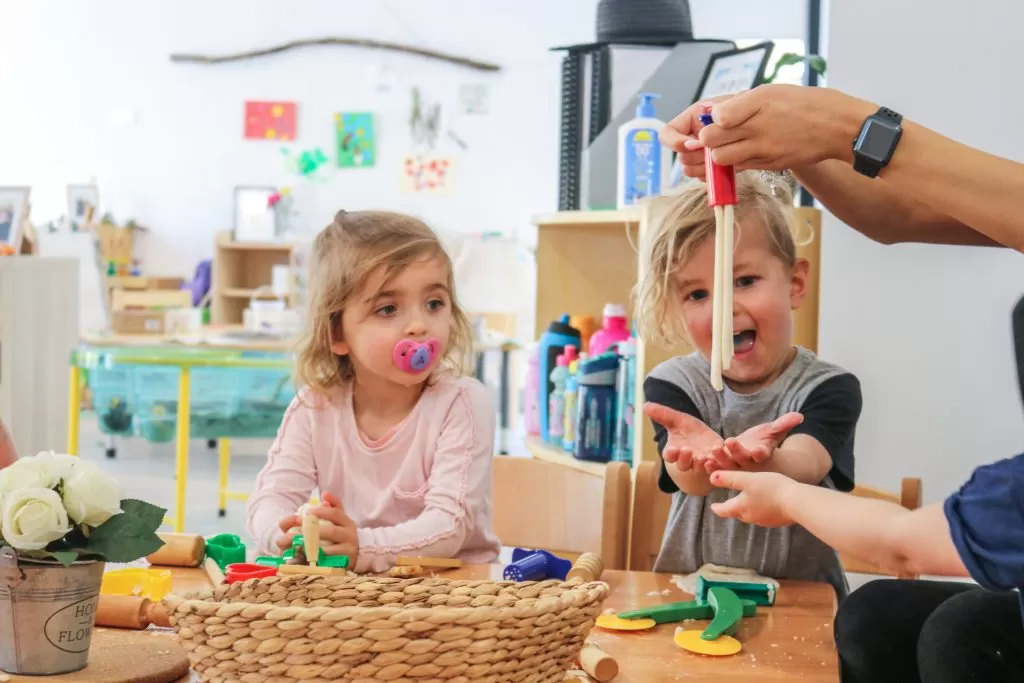
レッジョ・エミリア・アプローチとは何ですか?
The Reggio Emilia approach offers a distinctive perspective on early childhood education, rooted in respect for the child as an active participant in their own development. It invites educators and families to rethink traditional roles and see learning as a dynamic, collaborative journey.
レッジョ・エミリアのアプローチ哲学
The Reggio Emilia approach is a child-centered educational philosophy that views children as strong, capable, and full of potential. Originating in Reggio Emilia, Italy, after World War II, it is grounded in the belief that children construct their knowledge through meaningful interactions with their environment, peers, and adults. This approach emphasizes hands-on, project-based learning, where children are encouraged to explore their interests through multiple forms of expression—such as art, music, movement, and dramatic play. Teachers act as facilitators and keen observers, documenting the learning process and collaborating with children to deepen understanding.
レッジョ・エミリア・アプローチの歴史と起源
The Reggio Emilia Approach originated in Reggio Emilia, Italy, after World War II. The community, devastated by the war, sought to rebuild a more just and democratic society, starting with early childhood education.
この教育運動の中心となったのは ロリス・マラグッツィ、その レッジョ・エミリア・アプローチの創始者心理学者であり教育者でもあるマラグッツィは、子供たちが受動的な指示の受け手ではなく、知識を構築する積極的な参加者として見られる学校を思い描きました。
このアプローチは数十年にわたり、世界的に尊敬される教育モデルへと進化しました。創造性、批判的思考、そして有意義な人間関係を重視する姿勢は、ヨーロッパ、北米、そして世界中の幼稚園に影響を与えてきました。
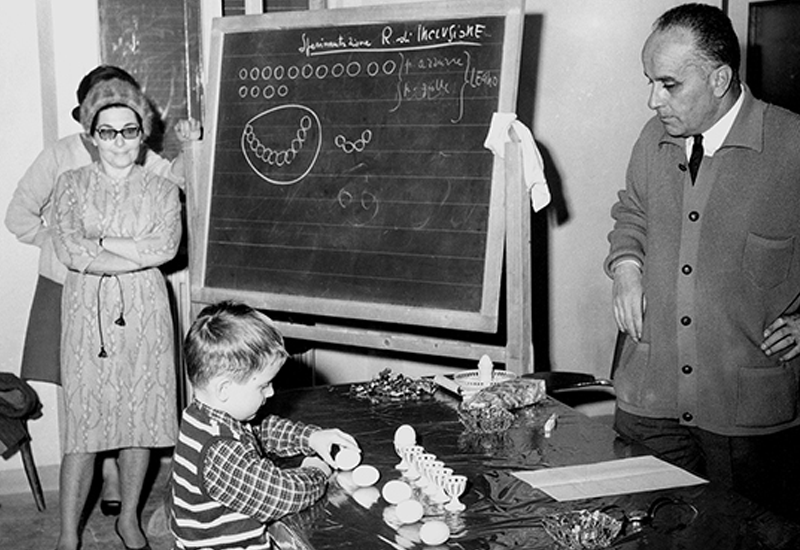
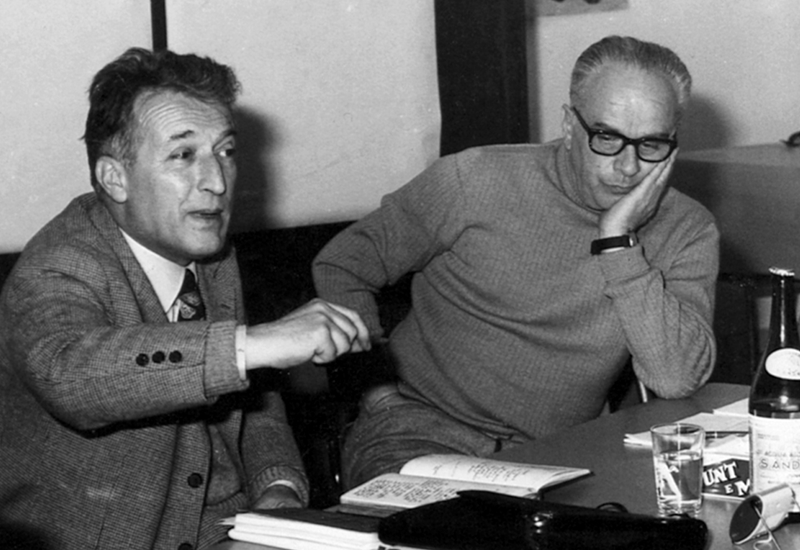
レッジョ・エミリア・アプローチ vs モンテッソーリ
The Reggio Emilia Approach and the Montessori Method are child-centered but differ in educational structure and philosophy. Reggio is inquiry-driven and collaborative; Montessori is structured and focused on independent mastery of materials.
| 側面 | レッジョ・エミリア・アプローチ | モンテッソーリメソッド |
|---|---|---|
| 学習スタイル | プロジェクトベース、創発的 | シーケンシャル、スキルベース |
| 教師の役割 | 共同学習者および協力者 | ガイドと観察者 |
| 環境 | 美しく、柔軟性があり、子ども向け | 整然とした、素材重視 |
| 表現 | 多様な創造的「言語」 | 定義された感覚材料 |
| 評価 | 文書化と対話 | 観察による習得 |
Both approaches respect the child as an active learner. The right choice often depends on the educational focus on creative collaboration or structured independence.
Key Principles of the Reggio Emilia Approach
The Reggio Emilia Approach is built on a foundation of guiding principles that shape every aspect of the learning environment. These principles go beyond teaching techniques; they reflect a deep respect for children’s rights, capabilities, and ways of knowing.
ここでは、明瞭さとインパクトを与えるピラミッド型の書き方に従って、最も重要なアイデアからそれをサポートするアイデアまで構造化された、中核となる原則の簡潔な内訳を示します。
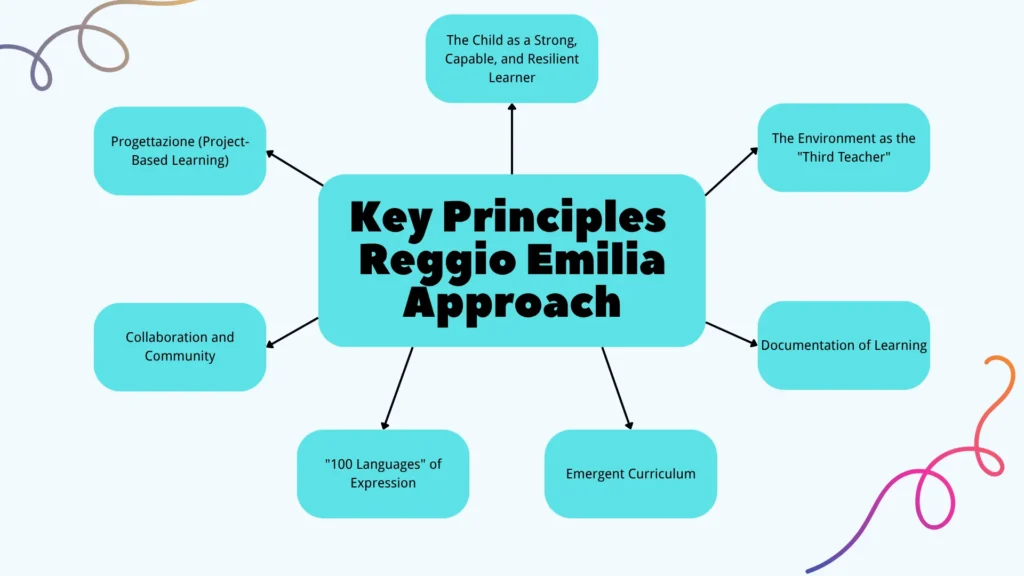
1. The Child as a Strong, Capable, and Resilient Learner
Children are viewed as competent individuals with the ability to construct their knowledge. They are not passive recipients of instruction, but active explorers with personal agency. Educators respect children’s ideas, encourage inquiry, and support learning through dialogue, reflection, and experimentation.
2. The Environment as the “Third Teacher”
The physical environment intentionally promotes exploration, autonomy, and interaction. Natural light, open-ended materials, and aesthetically considered spaces support focus, creativity, and collaboration. The classroom teaches, offering cues, challenges, and learning opportunities.
3. Documentation of Learning
Educators systematically observe and document children’s learning processes using photographs, transcriptions, and video recordings. This documentation is a tool for reflection, planning, and family communication. It makes children’s thinking visible and provides continuity and depth in curriculum development.
4. Emergent Curriculum
Curriculum arises from children’s interests and inquiries rather than from predetermined topics. Teachers observe children closely, identify themes in their play or questions, and then co-construct learning experiences that expand and deepen those interests. This approach maintains developmental relevance and student engagement.
5. The “Hundred Languages” of Expression
The approach recognizes that children express their understanding in multiple symbolic forms — visual arts, movement, music, storytelling, construction, and more. These forms are not secondary to verbal language; they are essential tools through which children represent, test, and refine ideas.
6. Collaboration and Community
Learning is considered a relational process. Children learn in interaction with peers, teachers, families, and the broader community. Cooperation, dialogue, and shared problem-solving are emphasized. Families are active participants in school life, and their involvement is integral to the educational experience.

7. Progettazione (Project-Based Learning)
Children engage in extended investigations, often collaboratively, centered on topics that emerge from their expressed interests. These projects support sustained inquiry and integrate multiple domains of learning. Teachers guide the process by introducing materials, posing questions, and helping children reflect on their work.
学習意欲を高める空間をデザインする準備はできていますか? 教室のニーズに合わせてカスタマイズされた家具ソリューションを作成するには、当社にご相談ください。
レッジョ・エミリア・アプローチの利点
The Reggio Emilia Approach is a practical, proven framework that delivers deep and lasting benefits for children, educators, and families. Its child-centered, inquiry-driven nature unlocks real developmental advantages that traditional models overlook.
1. 創造性と批判的思考力を促進する
One of the Reggio Emilia Approach’s greatest strengths is its ability to cultivate creative, independent thinkers. Instead of memorizing facts or completing predefined tasks, children are invited to explore real-world questions that emerge from their curiosity.
By encouraging experimentation, self-expression, and open-ended inquiry, the approach helps children develop a flexible, problem-solving mindset. They learn to test ideas, make decisions, and reflect. Creativity here is not a separate subject. It’s embedded in every interaction, every project, and every material children engage with.

2. 社会性とコミュニケーション能力を強化する
Children in Reggio-inspired classrooms constantly engage in conversation, group work, and collaborative decision-making. These interactions sharpen communication, listening, and negotiation skills from a very early age.
This collaborative environment encourages empathy and respect. Children learn to consider other perspectives, articulate their thoughts clearly, and find shared solutions within a socially supportive setting. Such skills are essential for academic success and navigating relationships in both school and life.
3. 感情的知性と自己制御を促進する
The Reggio Emilia Approach integrates emotional growth into the learning process. Under the guidance of observant educators, children are encouraged to express feelings, navigate challenges, and reflect on their emotional experiences.
Rather than disciplining behavior reactively, teachers help children understand their emotions, make thoughtful choices, and resolve conflicts with respect and autonomy. This builds stronger self-awareness and emotional resilience. As a result, children become more secure in themselves and better equipped to manage frustration, adapt to change, and build positive relationships.
4. エンゲージメントとモチベーションを高める
Because learning is based on what children care about, their focus and enthusiasm naturally increase. They are not simply following instructions; they are actively driving their learning journey. This sense of ownership fuels intrinsic motivation.
Children in Reggio-inspired environments show more persistence, initiative, and joy in their work. They dig deeper into topics, stay engaged longer, and take pride in their creations and discoveries. The Reggio Emilia Approach often leads to deeper understanding and better retention than traditional instruction.
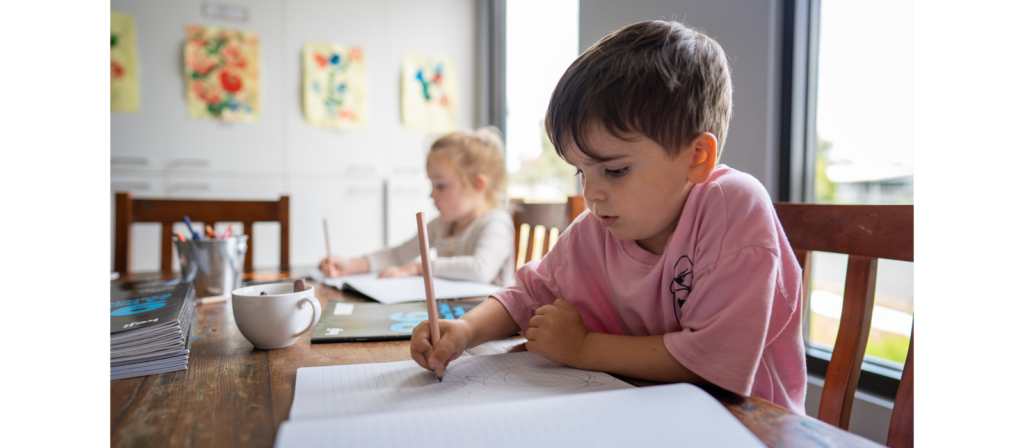
5. 保護者との強いパートナーシップを築く
It values and integrates parents into the educational process. Families are not just informed but invited to participate, observe, and contribute. Through transparent communication, documentation of learning, and regular involvement, parents gain a clearer view of their child’s development.
This strengthens trust and builds a learning community around the child that extends from school to home. Children feel more supported and connected when families feel seen and included, and their growth accelerates meaningfully.
レッジョ・エミリア・アプローチにおける教室環境
Referred to as the “third teacher”, the physical environment plays a central role in shaping how children explore, interact, and make meaning. Every element in the space is intentionally chosen to support inquiry, collaboration, and aesthetic appreciation.
1. 子どもを映し出す空間
Reggio-inspired classrooms are designed to feel like homes, studios, and laboratories combined. They are warm and welcoming and filled with natural light, plants, open shelving, and real-world materials. This design signals to children that they are respected and that their surroundings are worthy of care and attention.
Children can access a wide range of open-ended materials — such as fabric, clay, wood, wire, stones, and mirrors — inviting creativity and experimentation. Unlike traditional classrooms focusing on plastic toys or rote tools, these environments support flexible thinking and imaginative play.
Significantly, the classroom evolves. As children explore new interests, materials, and layouts are adjusted to reflect their questions and discoveries. In this way, the environment becomes a living expression of the children’s learning journey.
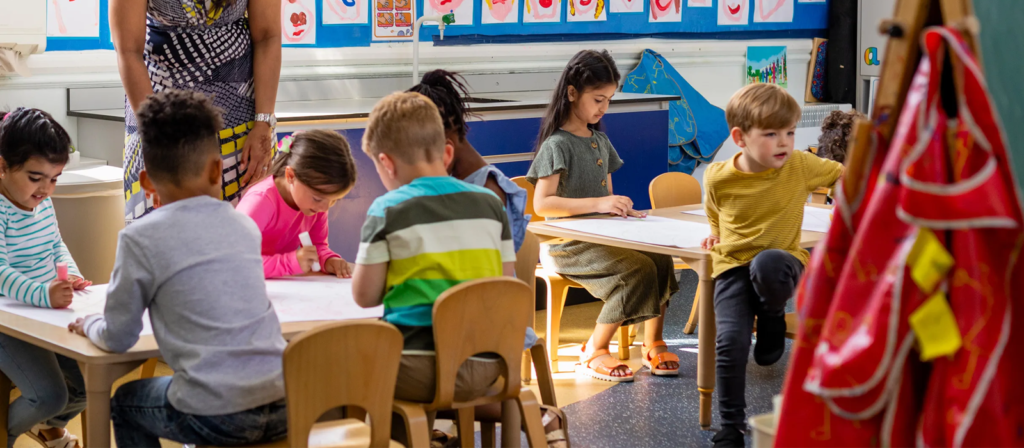
2. 透明性、アクセシビリティ、美しさ
A hallmark of the Reggio Emilia classroom is literal and figurative transparency. Glass walls, interior windows, and display panels are common, allowing visibility between spaces and making learning visible to others. Children can observe peers in other rooms, teachers can monitor interactions, and families can witness the learning process unfolding.
Materials and tools are placed at child height, fostering independence and autonomy. Open shelves allow children to choose resources freely. Display areas showcase not only finished work but also learning in progress, including drawings, drafts, conversations, and questions. This reinforces the idea that the process is just as important as the product.
The aesthetics of the space matter deeply. A beautiful environment communicates value. It inspires children to take pride in their work and to engage more thoughtfully with their surroundings. This principle, that beauty invites learning, is one of the most distinct characteristics of the Reggio Emilia Approach.
3. Flexible Spaces That Support Movement and Possibility
A Reggio Emilia classroom is intentionally designed to support movement, flexibility, and multiple layers of use. Rather than assigning rigid functions to fixed areas, the space invites transformation throughout the day. A reading corner may become a theater stage, a science table may turn into a construction zone, and a quiet area may evolve into a site for collaborative storytelling. This adaptability empowers children to reimagine how they use the environment based on their interests and intentions.
The Reggio-inspired layout promotes open circulation. Pathways are clear, wide, and unobstructed, allowing children to move freely between individual work, small group projects, and whole-class gatherings. Materials are organized in ways that encourage spontaneous use, and furniture is light and rearrangeable to support shifting group sizes and learning modes. Instead of confining children to specific stations, the environment offers a continuous flow that mirrors the way children naturally explore.
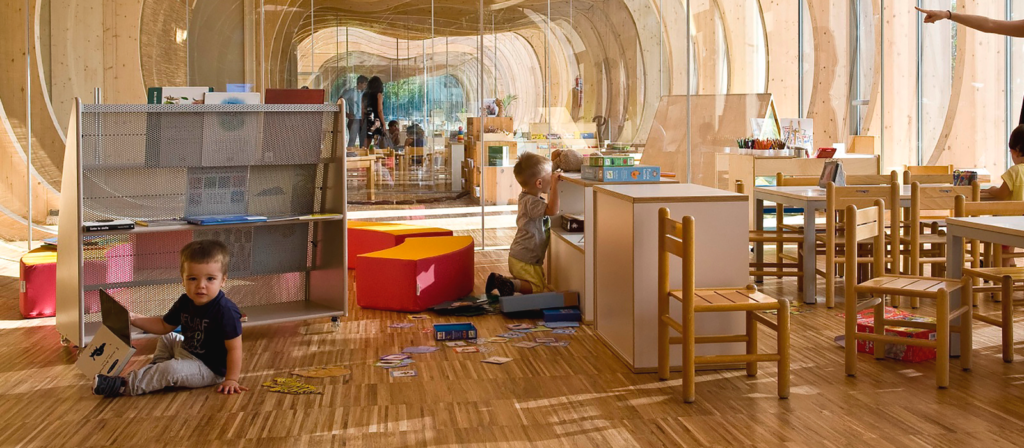
This fluid and layered design nurtures autonomy, decision-making, and self-regulation. Children learn to navigate space with purpose, make choices about where and how to work, and adapt their thinking as contexts change. The result is a dynamic classroom where the environment itself becomes a partner in discovery, supporting learning that is physical, intellectual, and creative all at once.
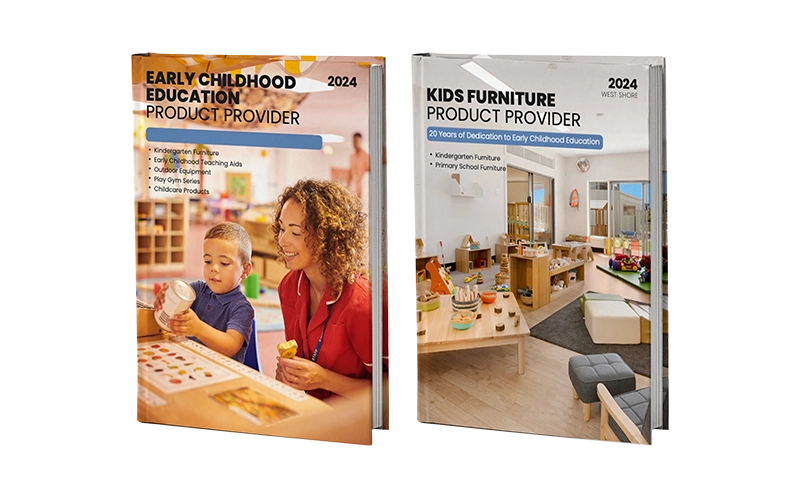
How to Define Spaces and Equip a Reggio-Inspired Classroom
Designing a Reggio-inspired classroom begins with the belief that the environment plays an active role in a child’s learning journey. Every space should reflect intention, purpose, and flexibility, allowing for both individual exploration and group collaboration. Rather than filling a room with furniture and materials, educators define each area with care, guided by how children move, interact, and express themselves.
1. Begin with the Child’s Perspective
Start by observing how children move, play, and interact. Consider their eye level, their reach, and the way they engage with their surroundings. All furniture, shelving, and materials should be placed to support independence. The room should feel welcoming, not overwhelming. By designing from the child’s point of view, the environment immediately becomes more accessible, comfortable, and empowering.
2. Define Learning Zones with Intention and Flexibility
Divide the room into zones that support different types of learning experiences. These might include an atelier for artistic expression, a construction area for building, a reading nook for quiet time, and a science table for exploration. Use soft spatial markers such as rugs, shelving, or lighting changes to separate zones without blocking flow. Keep in mind that zones should not be static. They can evolve, blend, and shift over time.
3. Choose Flexible, Natural Furniture That Supports Autonomy
The right furniture does more than fill a space — it defines how children interact with it. At ウェストショア家具, we produce preschool and kindergarten furniture specifically tailored to Reggio-inspired environments. Our designs prioritize modularity, accessibility, and natural aesthetics, using wood textures, smooth finishes, and rounded forms that invite exploration. Open-shelf units, mobile storage, adjustable tables, and seating scaled to the child’s body enable children to independently access materials, transition between zones, and manage their learning process. In the Reggio Emilia philosophy, furniture is not passive — it’s a pedagogical tool that quietly encourages agency and curiosity.
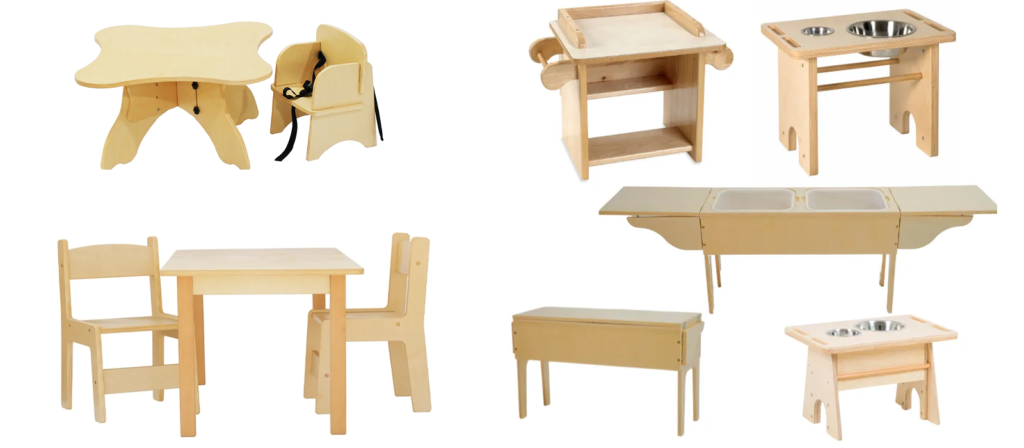
4. Creating Soft Boundaries for Flow
In Reggio Emilia classrooms, space isn’t static — it’s responsive. Defining learning zones starts by observing how children naturally move, gather, and explore. Rather than using fixed dividers or barriers, educators create “soft boundaries” using child-height shelving, rugs, lighting, and material displays. These visual and functional cues gently suggest purpose without limiting flexibility. The layout must support visibility, collaboration, and the child’s autonomy, essential values in the Reggio Emilia Approach. A thoughtful arrangement allows the environment to become an active participant in learning, rather than just a backdrop.

5. Equip Each Zone with Open-Ended, Purposeful Learning Materials
Beyond layout and furniture, the tools within each zone give meaning to the space. We offer a range of educational materials — including natural blocks, loose parts kits, sensory trays, mirror panels, and light table tools — designed to support creativity, scientific observation, and expressive play. These open-ended materials allow children to represent their thinking across disciplines and in multiple “languages,” a concept central to the Reggio Emilia Approach. Whether a child is documenting shadows, constructing habitats, or telling visual stories with clay, the right tools turn the environment into a place of endless possibility.
6. Allow the Environment to Evolve
A Reggio-inspired classroom is never static. As children’s interests change, the space must shift with them. Rearranging materials, rotating learning areas, or adding provocations based on new inquiries shows that the environment is alive. This flexibility supports curiosity and ensures that the classroom continues to reflect the children who inhabit it. A Reggio-inspired classroom is never finished. It is always in conversation with the children inside it.
レッジョ・エヴァンズ・インスパイア教室のキーゾーン
A Reggio-inspired classroom is not arranged by chance. Every space is intentionally designed to encourage exploration, collaboration, and creative expression. From the light and shadow center to the art studio, the classroom gives multiple pathways for children to communicate and learning. These zones are not rigid or static. They are flexible, evolving spaces that respond to children’s interests and inquiries.
1. アトリエ(アートスタジオ)
The atelier is a central hub where creativity takes shape. It is filled with high-quality art materials, natural elements, and open-ended tools. It functions as a creative studio that values process over product, inviting children to paint, sculpt, build, and invent. Rich in texture, color, and possibility, the atelier supports cognitive, emotional, and sensory development while encouraging collaboration and individual expression through the many “languages” of art.
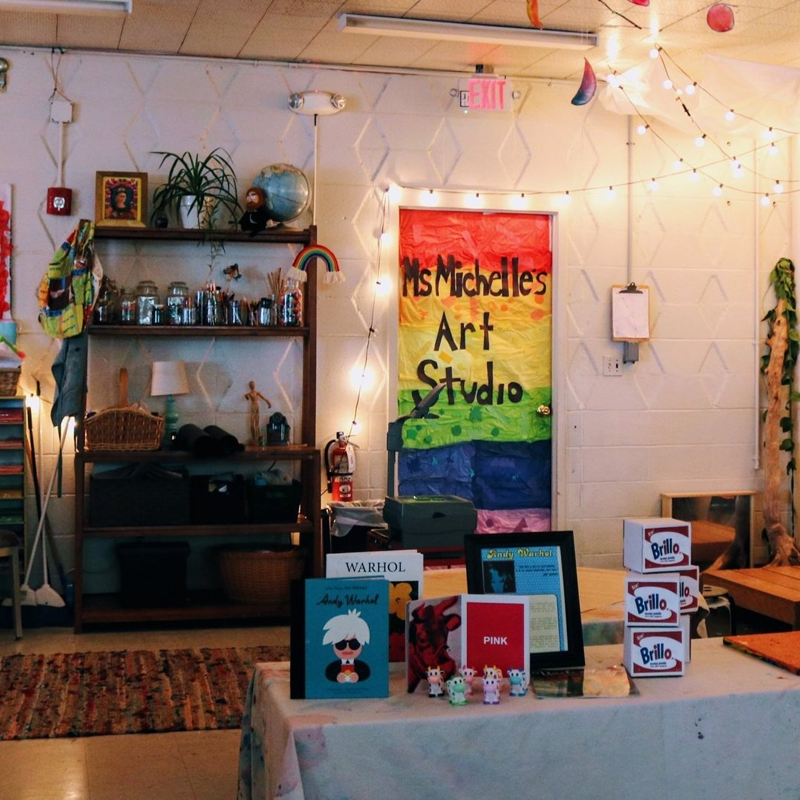
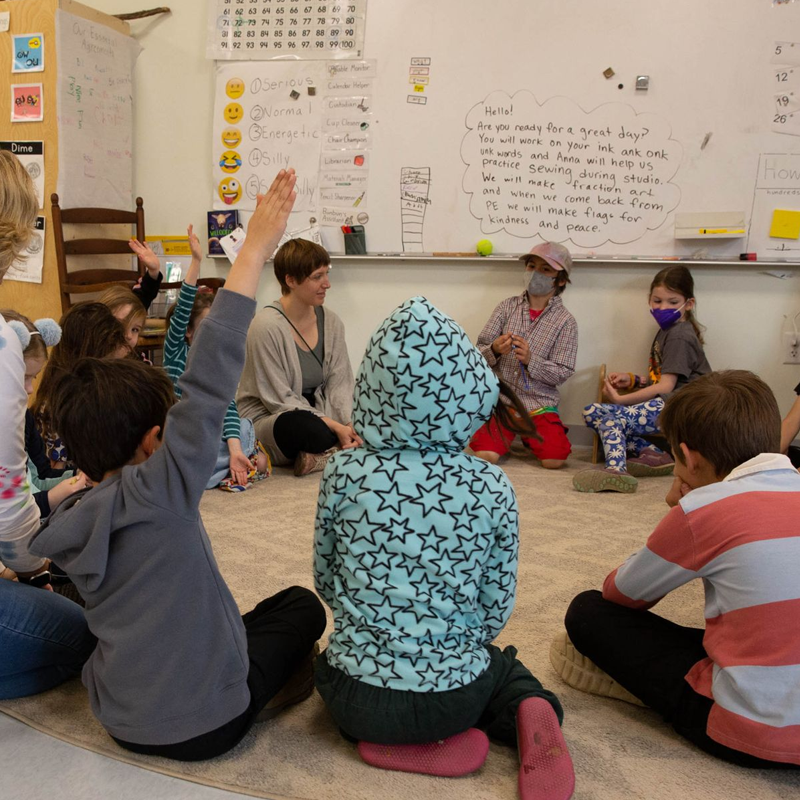
2. 広場(中央集会エリア)
The Piazza serves as the social hub of the classroom. Inspired by the Italian town square, it is a shared space where children gather for conversation, group projects, morning meetings, and storytelling. It reflects the belief that learning is inherently social and that children benefit from sharing ideas within a community.
3. 学習コーナーとミニラボ
Learning corners and mini-labs provide focused environments for inquiry into specific domains, such as science, construction, or storytelling. These smaller spaces encourage self-directed learning by allowing children to choose areas that align with their current interests. The design supports deep engagement, as children can explore materials and ideas without interruption. Children also build independence as they manage time and tools during exploration.
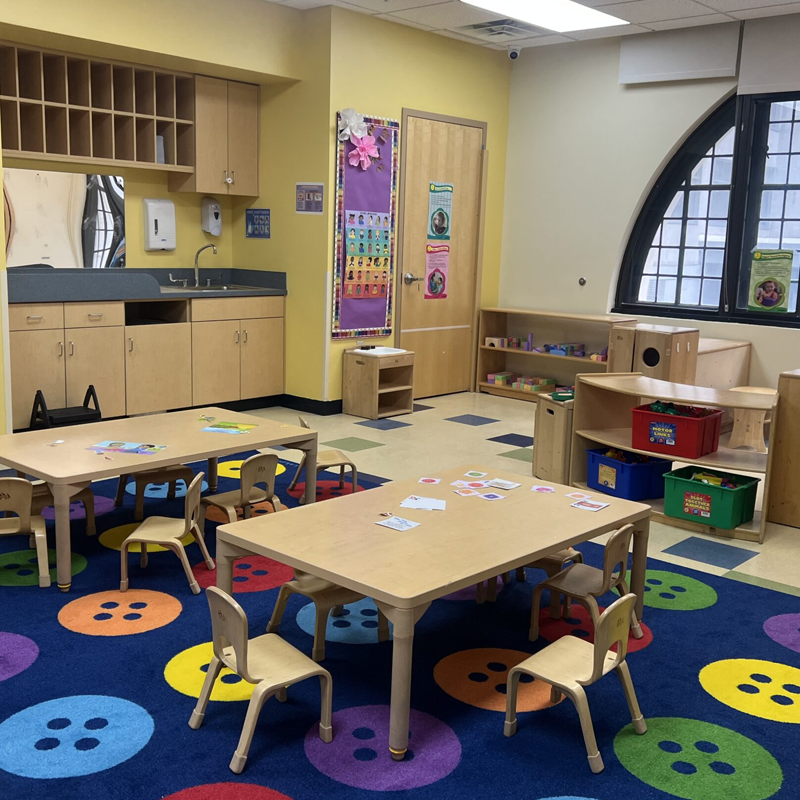

4. The Light and Shadow Center
Light is considered a powerful medium in Reggio-inspired learning. The light and shadow center gives children the chance to manipulate reflections, projections, and shadows, sparking curiosity about natural phenomena and abstract concepts. Through hands-on manipulation of light sources and materials, children engage in discovery and visual storytelling.
5. Quiet and Reflective Spaces
Quiet and reflective spaces respect each child’s rhythm by offering comfort and stillness within a busy classroom environment. These zones allow children to process their emotions, engage in individual reading or journaling, and build inner focus. By providing an intentional retreat, educators send the message that reflection is just as valuable as activity. Such spaces also support children in developing self-regulation and emotional awareness.
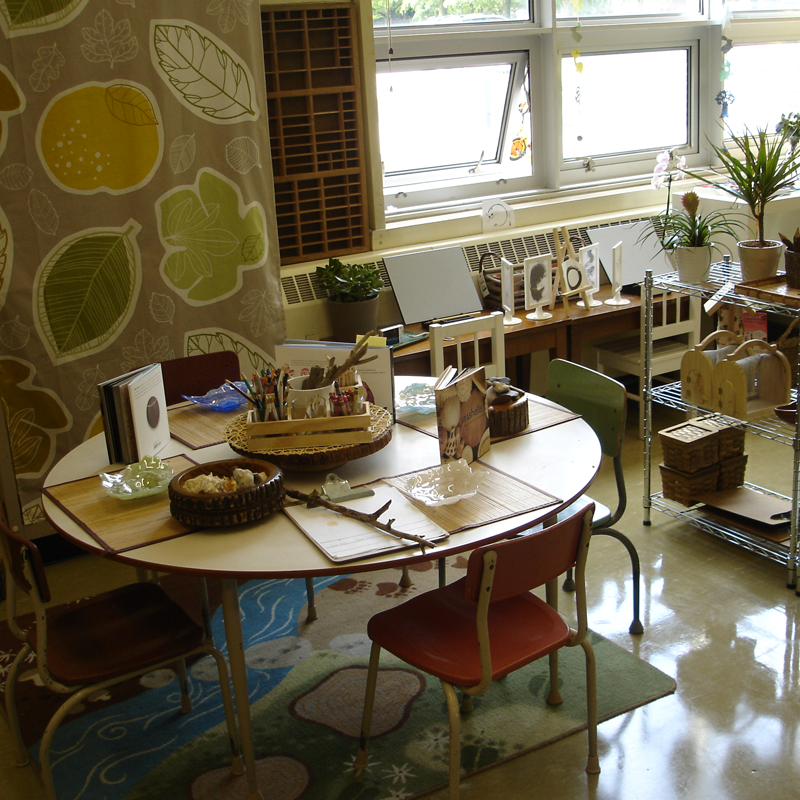
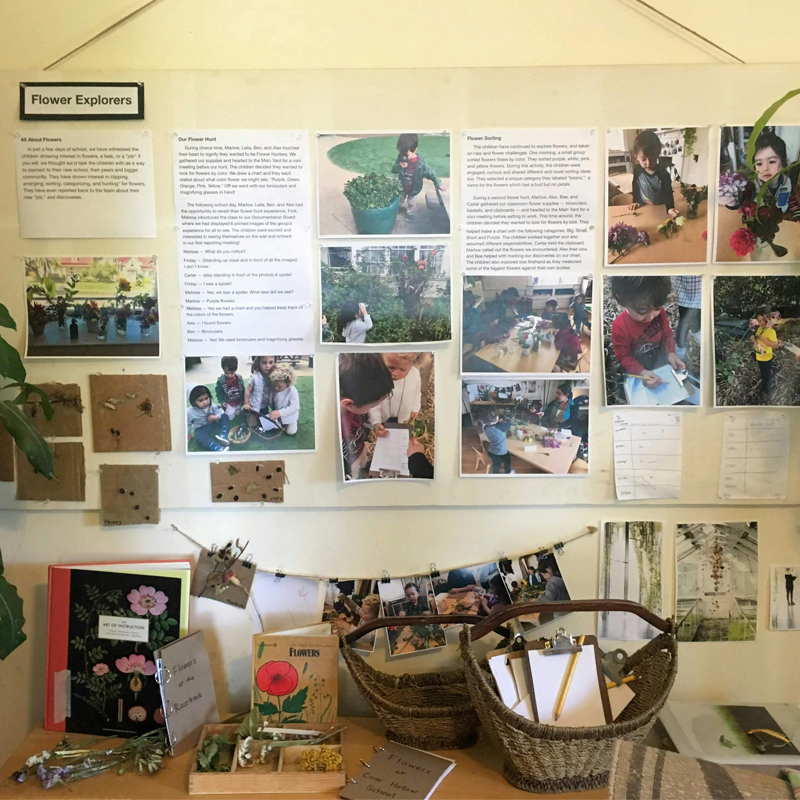
6. Display and Documentation Areas
Documentation is central to Reggio-inspired learning, and these areas serve as living records of children’s work. By displaying drawings and photos, teachers make the learning process visible to children, parents, and visitors. This practice not only validates children’s efforts but also encourages ongoing dialogue about their discoveries. Documentation areas evolve with projects, reinforcing that learning is dynamic, collaborative, and deeply connected to children’s experiences.
7. Natural and Outdoor Zones
Outdoor environments and natural zones are seen as extensions of the classroom, providing children with direct encounters with nature. Here, they engage with plants, weather, and natural materials, developing respect and curiosity for the living world. These spaces invite exploration of seasonal changes, life cycles, and environmental stewardship. By combining movement, sensory experiences, and observation, outdoor zones give children opportunities to learn holistically.
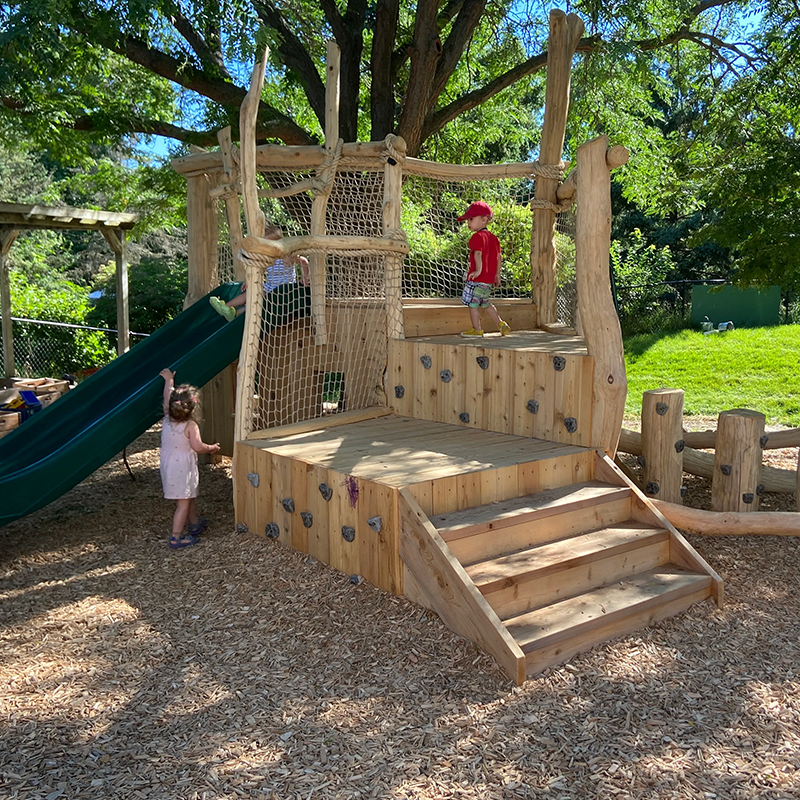
学習意欲を高める空間をデザインする準備はできていますか? 教室のニーズに合わせてカスタマイズされた家具ソリューションを作成するには、当社にご相談ください。
Teacher’s Role in the Reggio Emilia Approach
レッジョ・エミリア・アプローチにおいて、教師は教室の前に立って知識を授ける伝統的な権威者ではありません。むしろ、教師は研究者、協力者、聞き手、そして刺激者として捉えられ、子どもの上に立つのではなく、共に学ぶ存在です。この再定義された役割こそが、レッジョ哲学の成功の核心であり、従来の幼児教育とは一線を画すものです。
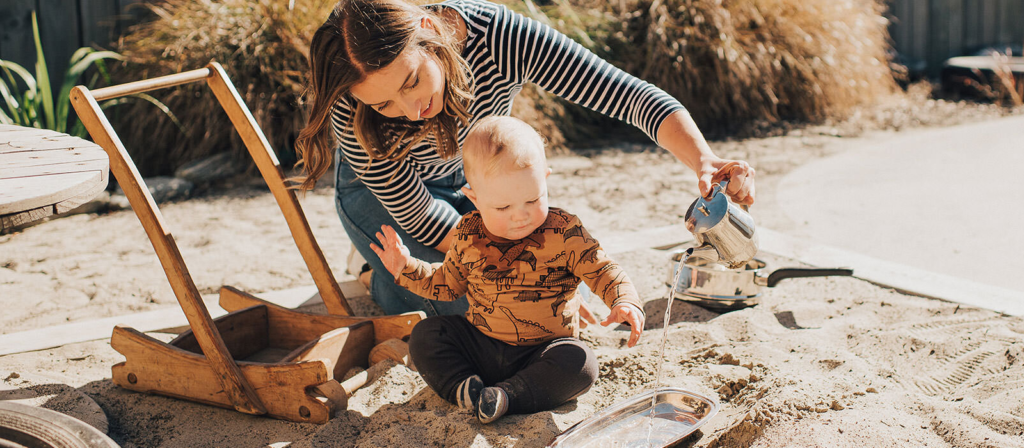
1. まず観察者と聞き手
レッジョ・エミリアの教師は、まず注意深く観察することから始めます。いきなり指示したり訂正したりするのではなく、子どもたちがどのように考え、何に興奮し、どのような質問をし、どのような理論を形成し始めるのかを理解するために、注意深く観察します。
Through attentive listening, teachers capture the intellectual processes behind the play, identifying the patterns, hypotheses, and relationships children naturally explore. These observations then guide the planning of future activities and the design of the learning environment.
This approach demands a high level of professional sensitivity. Teachers are not imposing a lesson plan; they uncover one already within the children.
2. 共同研究者および協力者
レッジョ・エデュケーションの教室では、教師は子どもたちと共に学びます。共に探究し、自由回答形式の質問を投げかけ、教材を使って実験し、発見について共に振り返ります。これにより、教師は単なるガイドではなく、探究のパートナーとして位置づけられます。
Rather than “delivering” knowledge, teachers encourage children to build their understanding. For example, if children wonder why rain makes puddles, the teacher might suggest they collect water on different surfaces, draw what they see, or build a water table. The teacher is not to give them the answer, but to extend their thinking.
This shared inquiry creates a culture of mutual respect. Children feel their voices matter because adults aren’t telling them what to think — they think with them.
3. 記録者およびコミュニケーター
A unique and vital responsibility of the Reggio Emilia teacher is documentation. Teachers record children’s dialogue, photograph their work, and reflect on the learning process. This is not simply for assessment. It is a way to make learning visible, shareable, and open to reflection.
Documentation allows teachers to revisit ideas with children, track development over time, and communicate meaningfully with families and colleagues. These records become part of the learning environment. They are displayed on walls, included in portfolios, and used during parent-teacher conversations to deepen understanding and collaboration.
Through documentation, the teacher reinforces the value of each child’s thinking while engaging in continuous professional self-evaluation.
レッジョ・エミリア・アプローチにおける教師は決して受動的ではありませんが、その力は支配からではなく、注意深さ、好奇心、そして敬意から生まれます。彼らは従うことで導き、聞くことで教え、学ぶことで導きます。
教師の役割は大変ですが、同時に非常にやりがいのあるものです。教師が自らを知識の共創者と位置づけることで、子どもたちは学びに主体性を持つようになり、目的意識と好奇心を持って世界を探求する自信を育むことができます。
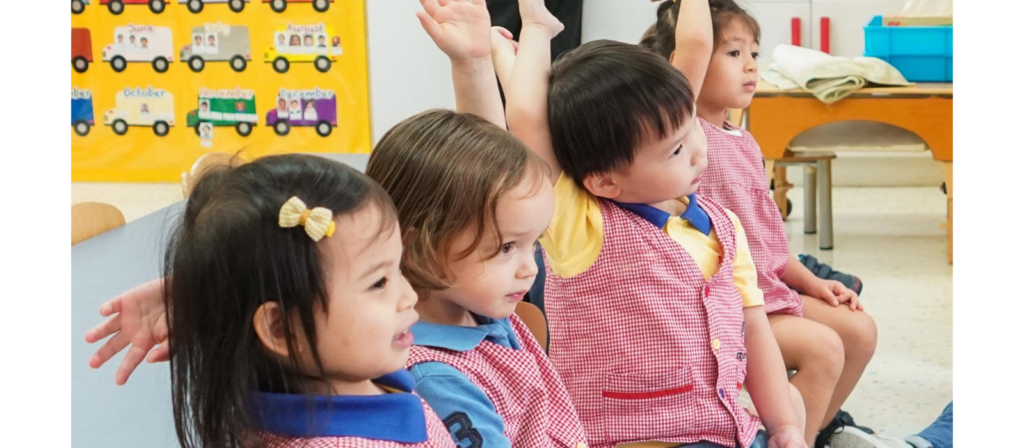
レッジョ・エミリア・アプローチにおける評価と記録
In the Reggio Emilia Approach, assessment is not a test at the end of a unit or a checklist of skills. Instead, it is a continuous, qualitative, and collaborative process known as documentation. This approach honors the complexity of children’s thinking by making their learning visible to themselves, teachers, and families.
1. 学習ツールとしてのドキュメンテーション
Teachers in Reggio Emilia classrooms systematically observe children’s interactions, questions, creations, and conversations. They capture these moments through written notes, audio recordings, photographs, video, and children’s work samples.
But documentation is not simply collecting evidence; it’s interpreting and reflecting. Educators use these artifacts to analyze how children construct knowledge, what theories they develop, and how their ideas evolve. It also helps identify new opportunities to extend inquiry.
このプロセスは、評価をカリキュラム開発のための動的なツールへと変化させます。記録は将来の計画に直接影響するからです。これは、事前に決められた型通りの指導ではなく、状況に応じた対応型の指導モデルをサポートします。
2. 学習を可視化する
A key purpose of documentation is to make children’s thinking and learning visible, not only to teachers but also to children and families. Visual displays that include photos, transcripts of dialogue, and project boards are commonly found throughout Reggio-inspired environments.
When children see their words and work displayed on the walls, it affirms their ideas and supports metacognition. This ability to reflect on their own learning helps them revisit past thinking, make meaningful revisions, and form new connections that deepen understanding.
For parents, this visibility builds trust and deepens involvement. Rather than waiting for end-of-term reports, they are regularly invited into the learning journey through exhibitions, journals, and shared reflections.
3. 従来の評価方法の再考
レッジョ・エミリア・アプローチは、幼児期における標準化されたテスト、成績、そして厳格な基準を意図的に否定します。レッジョの教育者は、「子どもは何点取ったか?」と尋ねる代わりに、次のように問いかけます。
- 子供は何に興味がありますか?
- 子供はどのようにして世界を理解しているのでしょうか?
- 彼らの調査を通じてどのようなスキルが生まれているのでしょうか?
- 彼らの選択を通してどのような価値観が表現されているのでしょうか?
This shift from evaluation to interpretation respects the complexity of learning. It values not what a child has memorized but how they think, question, collaborate, and create.
It also demands more from educators. Adequate documentation requires time, focus, and professional insight. However, the reward is a more authentic and holistic view of each child’s development.
In the Reggio Emilia Approach, assessment is woven into the fabric of daily life. It is not something done to children, but something done with them. It becomes a shared reflection on learning that fosters deeper insight, strengthens relationships, and supports a culture of continuous growth.
It is not about measuring learning. It is about seeing it, honoring it, and building upon it.
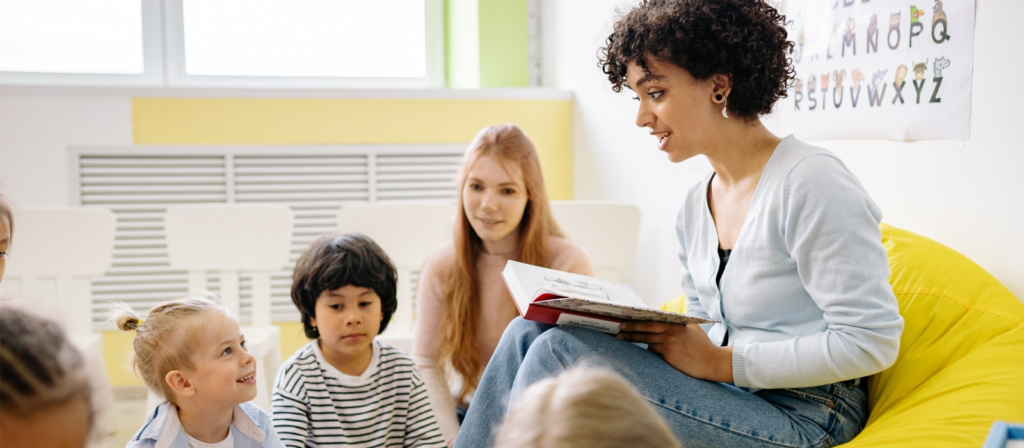
学習意欲を高める空間をデザインする準備はできていますか? 教室のニーズに合わせてカスタマイズされた家具ソリューションを作成するには、当社にご相談ください。
レッジョ・エミリア・アプローチにおける親とのパートナーシップ
One of the Reggio Emilia Approach’s most distinctive and potent features is its view of parents not as clients or passive observers but as active partners in their child’s learning journey. This deep commitment to family involvement is not a side note but a core pillar of the philosophy. The school, the teacher, and the parent form a triangle of trust, each playing a vital role in shaping the child’s development.
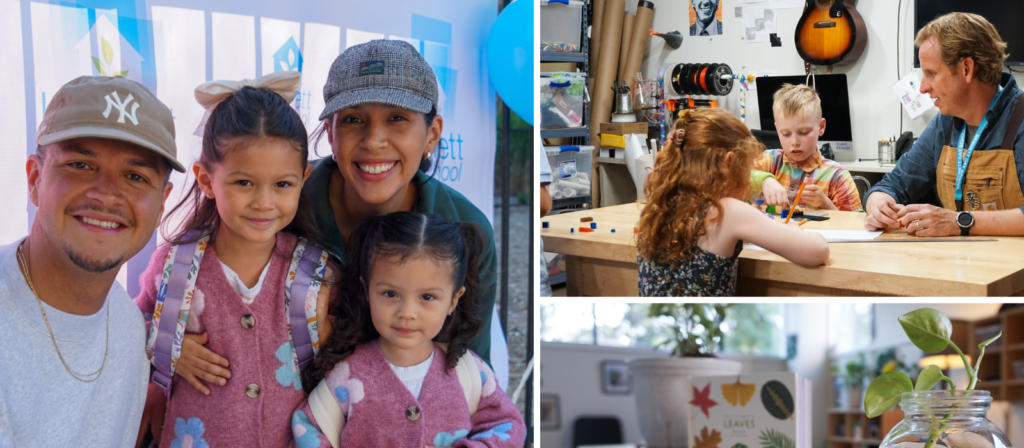
1. 親は共同教育者として
In Reggio-inspired schools, parents are seen as the first and most influential educators in a child’s life. Rather than being told what the school is doing, families are invited to participate in shaping the learning environment and curriculum.
これには次のものが含まれます:
- 教師との定期的な議論や計画会議への出席
- 教室のプロジェクトを充実させるために、自宅から材料や物語を持ち寄る
- 子どもの作品展への参加
- Helping co-document or interpret their child’s thinking
This collaborative approach builds mutual respect and allows educators to better understand the cultural, emotional, and intellectual context each child brings to the classroom.
2. 透明なコミュニケーションと共有の反省
A hallmark of the Reggio Emilia Approach is its use of documentation to promote open and transparent communication with families. Teachers share learning journals, photo displays, transcribed conversations, and even video snippets not as proof of productivity, but as windows into the child’s mind.
保護者の皆様には、この記録について振り返り、質問したり、意見を述べたり、家庭での観察を共有したりすることをお勧めします。こうした双方向の対話は、学校と家庭の価値観の一貫性を保ち、お子様が両方の環境においてより安心感とサポートを感じられるよう促します。
Regular parent-teacher meetings in Reggio settings are less about performance and more about shared meaning-making, understanding who the child is, what excites them, and how to support them as a team.
3. コラボレーションを通じたコミュニティの構築
The Reggio Emilia philosophy extends beyond the individual classroom. It actively fosters community among families, encouraging collective ownership of the educational space. Parents may work together on projects, school-wide installations, or cultural celebrations.
Many Reggio schools even include parent spaces within the school, where families can meet, share coffee, or exchange ideas. This physical integration signals a more profound truth: families are not visitors, but respected learning community members.
The result is a culture in which children see that learning is not confined to school walls. They feel the support of a larger, interconnected web of adults who listen to them, learn from them, and grow with them.
In the Reggio Emilia Approach, partnering with parents is not just beneficial but essential. When families and educators collaborate authentically, the child stands at the center of a strong, supportive network. This foundation enhances learning and builds the kind of trust, empathy, and shared responsibility that defines a truly human approach to education.
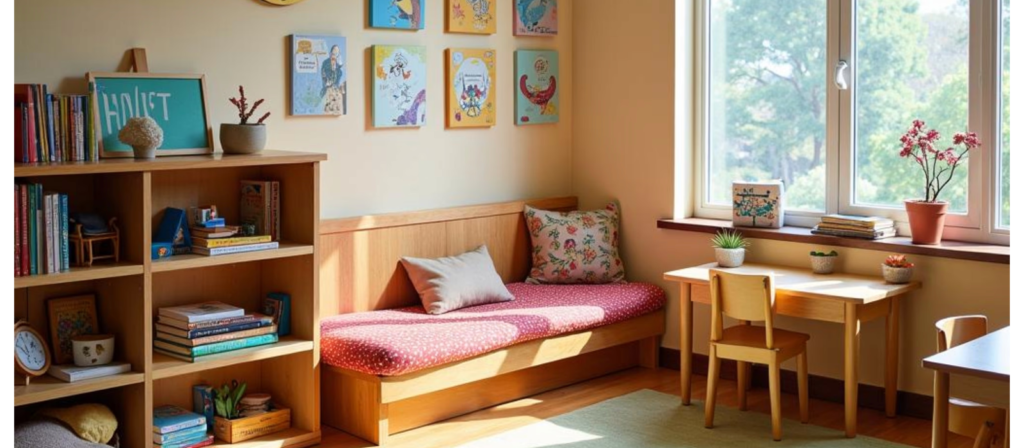
レッジョ・エミリア・アプローチを家庭で実践する
レッジョ・エミリア・アプローチは学校だけにとどまりません。家庭における子どもたちの学びと成長にも変革をもたらします。親や保護者にとって、家庭でレッジョ・エミリアの原則を実践することは、子どもたちが自分の意見を聞いてもらえ、尊重され、自由に探求できる環境を作ることを意味します。高価な教材や専用のスタジオは必要ありません。必要なのは、意図的な選択、創造性を育むためのオープンな空間、そして子どもを有能で好奇心旺盛な学習者として尊重する姿勢だけです。
1. 柔軟で刺激的な環境を作る
まずは物理的な空間を見直すことから始めましょう。レッジョ・エミリア様式の家庭では、環境は第三の教師として扱われます。お絵かき用のコーナー、パーツや自然素材を置く棚、組み立てや整理のためのテーブルなど、すでにあるものを活用して、小さくて柔軟な学習ゾーンを作ることができます。
材料は見える場所に置き、簡単に取り出せるようにしましょう。バスケットやオープンシェルフなどを使い、子どもたちが自分で興味のあるものを選べるようにしましょう。紙、粘土、布、ボタン、小枝、段ボール、さらにはリサイクル容器など、様々な材料を用意しましょう。こうした材料は自由な遊びを促し、想像力と問題解決能力を育みます。
自然光、植物、鏡、そしてシンプルな美しさは、大きな違いを生み出します。美しく、意図的な空間は、子どもに「ここはあなたのアイデアが大切にされる場所よ」と伝えます。
2. Follow the Child’s Interests
Reggio Emilia learning is child-led. At home, this means observing your child’s play and questions and extending those interests with gentle prompts and resources. If your child is fascinated by insects, for example, you could:
- 葉っぱと虫眼鏡を集めて屋外で虫を観察する
- 昆虫の生息地を一緒に描く
- 粘土やリサイクル材料を使って昆虫を作る
- 昆虫をテーマにした本を読んだり、物語を作ったりする
The key is to avoid rushing to teach or correct. Instead, be a co-learner, explore the topic with your child, ask questions, and support their discoveries. Let their curiosity guide the direction.
3. 多様な表現形式を奨励する
Support your child’s thinking through the hundred languages — drawing, music, movement, building, storytelling, and more. Avoid focusing on perfect results. Instead, ask reflective questions like:
- 「これを作ったとき、何を考えていましたか?」
- 「次は何を試してみることができますか?」
- 「あなたの絵について教えていただけますか?」
These questions affirm their thought process and invite deeper reflection. You can also keep a portfolio of their work, not for judgment, but to revisit and reflect on their growth over time.
Even very young children benefit from this: when you document their marks, movements, or phrases, you convey that their ideas are worth remembering.
4. 尊敬と協力の文化を築く
Implementing the Reggio Emilia Approach at home isn’t just about materials and values. Respect your child’s voice, include them in decisions, and model active listening. You can also involve them in everyday tasks like cooking, gardening, or setting up play areas, treating these not as chores but as meaningful learning experiences.
子どもたちが仲間入りしたと感じると、自信、自立心、そしてより強いアイデンティティが育まれます。家族は、単なる権威者ではなく、学習の協力者となるのです。
Bringing the Reggio Emilia Approach home doesn’t mean replicating a preschool. It means creating a home where exploration is welcomed, creativity is nurtured, and children are trusted to lead their learning.
私たちがどのように聞き、観察し、やり取りするかを少し変えるだけでも、子どもたちが自分自身を単なる学生としてではなく、有能な思考者や創造者として見るようになるという、永続的な変化をもたらすことができます。
学習意欲を高める空間をデザインする準備はできていますか? 教室のニーズに合わせてカスタマイズされた家具ソリューションを作成するには、当社にご相談ください。
レッジョ・エミリア・アプローチ活動
レッジョ・エミリア・アプローチにおける活動は、あらかじめ決められた授業や画一的な課題ではなく、子どもたちの自然な好奇心から生まれる、意味のある探求活動です。これらの活動は、自由回答形式で、プロジェクトベースであり、実社会での経験に深く根ざしています。目標は、単に教科を「教える」ことではなく、子どもたちが自ら考え、疑問を持ち、創造し、協力し合うことを促すことです。
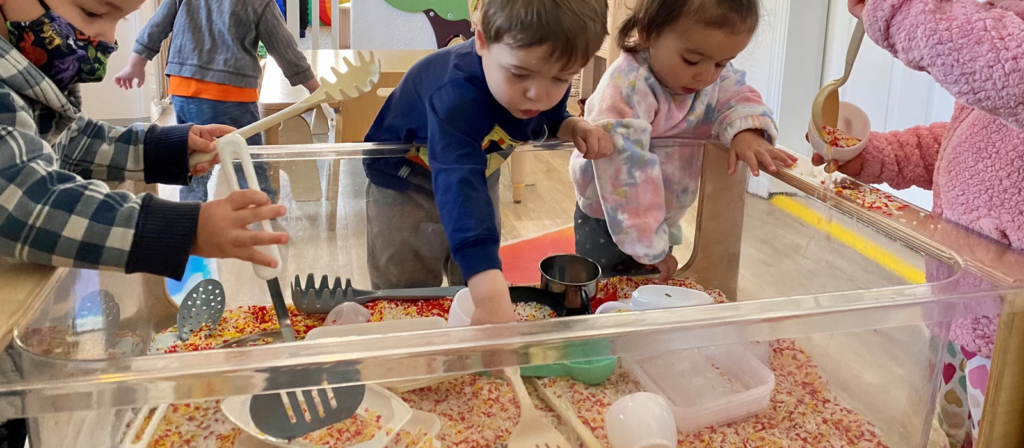
1. Nature Walk and Material Exploration
Children go on a nature walk and collect found objects such as leaves, stones, twigs, and flowers. These items are brought back to the classroom for closer examination and creative use. Children observe textures and patterns, make nature collages, or use the objects as tools in painting or printing. The experience connects them with the environment and fosters observation skills.
This activity enhances sensory awareness, builds scientific curiosity, and encourages symbolic representation. Children learn to see the world in new ways and express their interpretations through art and storytelling.
必要な材料:
- Baskets or bags for collecting
- Magnifying glasses
- Paper and pencils
- Glue and scissors
- Cardboard or canvas for collages
2. Shadow and Light Investigation
Children explore how light behaves using flashlights, mirrors, translucent materials, and projectors. They experiment by casting shadows, reflecting light, and creating moving images. As they play with shapes and shadows, they begin to develop theories about light and movement.
This activity nurtures early scientific thinking, spatial awareness, and visual storytelling. It also invites children to express abstract ideas and emotions using nonverbal forms of communication.
必要な材料:
- Flashlights
- ミラー
- White sheets or walls
- Transparent colored paper or cellophane
- Cut-out figures or puppets
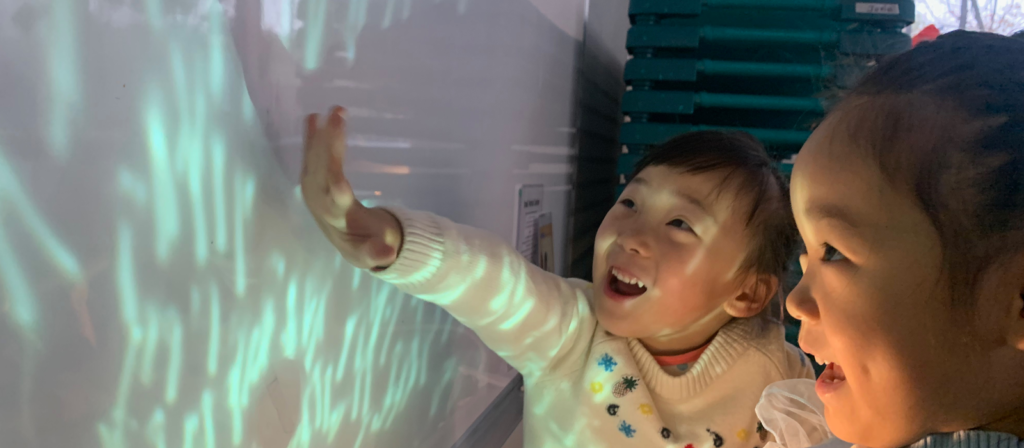
3. Collaborative Mural Painting
A large shared mural invites children to co-create a painting using brushes, hands, natural objects, or found materials. They may respond to a shared prompt or develop a spontaneous scene. Through group discussion and joint decision-making, children learn to negotiate space, ideas, and contributions.
This activity promotes cooperation, emotional expression, and creative confidence. It helps children learn how to listen to others, contribute their voice, and build a shared vision.
必要な材料:
- Large roll of paper or canvas
- Paints and brushes
- Sponges, leaves, or textured objects
- Aprons or smocks
- Tape for mounting the mural on the wall or floor
4. Building with Recycled Materials
Children design and construct with boxes, tubes, caps, and scrap fabrics. They imagine homes, cities, or fantastical creatures, experimenting with form, balance, and connection. The process is guided by their own interests, and the outcomes often evolve over days.
This activity strengthens problem-solving, fine motor coordination, and design thinking. It also teaches sustainability and encourages children to see creative potential in everyday materials.
必要な材料:
- Cardboard boxes and tubes
- Bottle caps and lids
- Glue, tape, and scissors
- Fabric scraps or yarn
- Paper fasteners or pipe cleaners
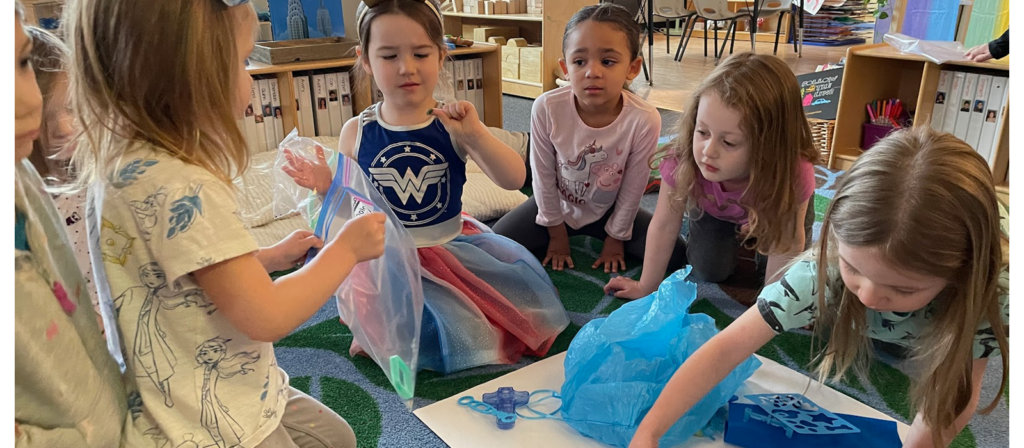
5. Story Mapping with Loose Parts
Children use small loose items to create characters and settings for original stories. They arrange materials on a mat or table and tell their story verbally, through drawing, or by recording it digitally. Each story can be revisited, altered, or expanded later.
This activity builds narrative thinking, vocabulary, and sequencing. It supports symbolic play and gives children alternative ways to express complex ideas and emotions.
必要な材料:
- Wooden blocks or discs
- Stones and buttons
- Shells, string, and felt
- Story mats or trays
- Drawing paper or digital recorder
6. Emotional Expression through Clay
Children are invited to shape clay into symbols of their thoughts or feelings. They may sculpt “what happiness looks like” or build a clay memory of a favorite place. The tactile nature of the material allows for deep sensory and emotional engagement.
This activity supports emotional intelligence, self-awareness, and mindfulness. Working with clay also strengthens hand muscles and encourages sustained concentration.
必要な材料:
- Natural clay or air-dry clay
- Clay tools or sticks
- Aprons or table covers
- Small containers of water
- Photographs or story prompts (optional)
レッジョ・エミリア・アプローチの課題と批判
While the Reggio Emilia Approach is widely admired for its innovation and child-centered values, it is not without limitations. Understanding these challenges is crucial for educators, school founders, and policymakers to make informed decisions about implementation and long-term sustainability.
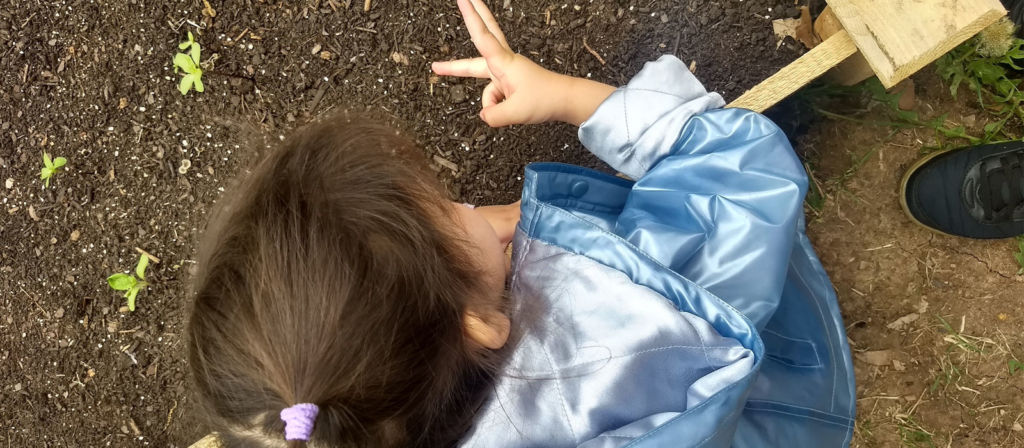
1. 標準化の欠如
One of the most frequent criticisms of the Reggio Emilia Approach is its lack of a fixed curriculum or formal assessment system. Because learning is emergent and shaped by children’s interests, there are no preset benchmarks or standardized learning outcomes.
While beneficial in many ways, this flexibility can also make it difficult to measure progress objectively. This can be a significant barrier for school administrators or government bodies looking for consistent metrics. Teachers must rely on documentation and professional judgment rather than external testing, which can raise concerns about accountability and educational quality in some contexts.
Furthermore, without a universal framework, the quality of Reggio-inspired programs can vary widely depending on individual schools’ training, resources, and interpretation.
2. 教師への高い要求
Implementing the Reggio Emilia Approach requires educators to take on multiple complex roles as teachers, researchers, documenters, designers, and collaborators. This demands high training, observation skills, and pedagogical reflection.
教師は、学習環境を常に適応させ、子どもたちの考えにリアルタイムで反応し、学習プロセスを詳細に記録することが求められます。これは、特に教員数が限られている学校や生徒と教師の比率が高い学校では、非常に時間がかかり、精神的にも負担が大きくなる可能性があります。
Without proper support and ongoing professional development, even skilled teachers may struggle to fully realize the philosophy in daily practice.
3. 資源集約型環境
The Reggio Emilia classroom is more than a room with tables and toys. A curated environment stimulates inquiry, autonomy, and aesthetic appreciation. Schools must invest in quality materials, flexible furniture, and thoughtful design, often using natural and real-world elements like wood, metal, mirrors, and recycled items.
Recreating this environment can be financially and logistically challenging for new or budget-limited schools. Sourcing age-appropriate, open-ended materials and continuously updating them to reflect children’s evolving interests adds ongoing operational pressure.
Documentation tools (cameras, printing, display spaces) and teacher planning time must be factored into the budget and daily workflow.
4. 文化的および構造的な不一致
レッジョ・エミリア・アプローチは、協力、公的資金、地域社会の関与が強いイタリア特有の文化的、政治的背景の中で生まれましたが、他の国への移転は必ずしもスムーズではありません。
The approach may face resistance in systems where standardized testing, rigid curricula, or limited parent engagement are the norm. Some schools find it challenging to reconcile Reggio principles with external mandates, such as early literacy benchmarks or government inspections.
適応を成功させるには、表面的な修正だけでなく、体系的な変化がしばしば必要になります。それがなければ、理念が薄められたり、誤って適用されたりするリスクがあります。
The Reggio Emilia Approach is robust but also demanding. It requires deep commitment, flexible thinking, and long-term professional development and classroom infrastructure investment.
Understanding these challenges is not a reason to reject the approach; it’s a reason to prepare well. With the right mindset and resources, many of these obstacles can be transformed into opportunities for growth.
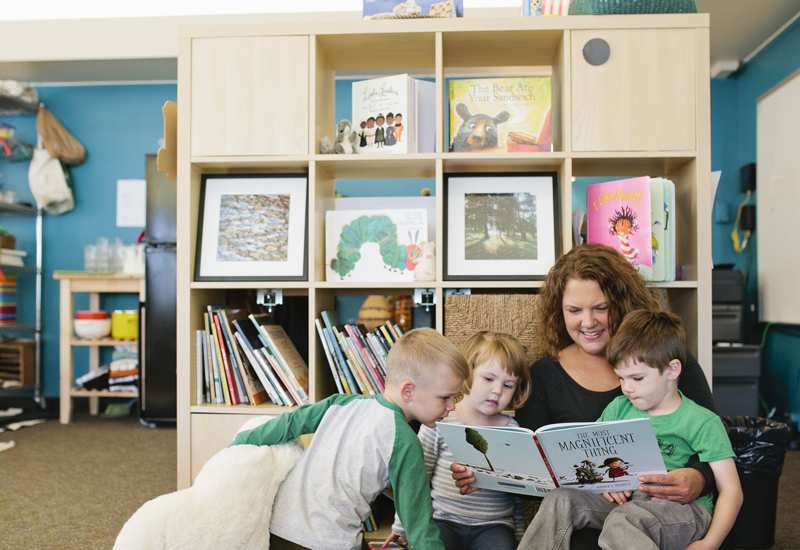

学習意欲を高める空間をデザインする準備はできていますか? 教室のニーズに合わせてカスタマイズされた家具ソリューションを作成するには、当社にご相談ください。
結論
The Reggio Emilia Approach reshapes early childhood education by placing children at the center of their learning. Through open-ended inquiry, expressive languages, and collaboration, it empowers young learners to construct meaning rather than passively absorb content. This framework doesn’t just teach, it helps children think, feel, and imagine in ways that last a lifetime.
Implementing this approach requires more than philosophy; it demands environments that mirror its values — flexible, beautiful, and built for exploration. That’s why thoughtfully designed furniture and adaptable classroom zones matter. Manufacturers like ウェストショア家具, which specialize in early childhood furniture solutions, quietly support this vision by crafting environments that align with Reggio principles, giving ideas physical form without compromising safety, simplicity, or child-led accessibility.
The actual impact of the Reggio Emilia Approach is not in how well we recite its principles, but in how we translate them into living spaces, relationships, and daily practice. The transformation starts now for those ready to listen, observe, and build with intention.
FAQ: Reggio Emilia Approach
Q1: How is the Reggio Emilia program different from most other preschool programs?
答え: The Reggio Emilia Approach differs from other programs by emphasizing emergent, child-led curriculum, where learning arises from children’s interests rather than pre-set themes. For example:
- Unlike モンテッソーリ, which uses sequenced materials and structured tasks, Reggio promotes open-ended projects with no fixed outcomes.
- Unlike HighScope, which uses a “plan-do-review” structure and emphasizes routine, Reggio classrooms are more flexible and responsive.
- Compared to Te Whāriki from New Zealand, which also values cultural context and holistic learning, Reggio places a stronger emphasis on aesthetic environment and visual documentation as part of the learning process.
To explore how Reggio compares with other major models, visit our comprehensive Preschool Curriculum overview.
Q2: What is Reggio Emilia’s famous quote?
答え: The most well-known quote from Reggio Emilia’s founder, Loris Malaguzzi, is:
“The child has a hundred languages.”
It refers to the countless ways children express themselves through art, movement, storytelling, and more.
Q3: Is Reggio Emilia evidence-based?
答え: Yes, while not a standardized model, the Reggio Emilia Approach is supported by decades of global practice, child development theory, and educational research emphasizing creativity, autonomy, and social learning.
Q4: Are Reggio Emilia schools expensive?
答え: Reggio Emilia schools can be more expensive than traditional preschools due to the low teacher-child ratios, high-quality materials, and thoughtfully designed environments. However, costs vary by region and institution.
Q5: What does a typical day look like in a Reggio Emilia preschool?
答え: A typical day in a Reggio Emilia-inspired preschool is guided by children’s interests rather than a rigid schedule. The day often begins with a morning gathering in the “piazza” (central space), followed by time for project work, where children explore topics using materials like clay, paint, blocks, or found objects.
Teachers observe and document while children collaborate in small groups, often moving between zones like the atelier (art studio), reading corners, or outdoor gardens. There are opportunities for snack time, free play, and reflection, but transitions are gentle and responsive to the children’s flow of engagement.
Every activity is seen as a chance to express, discover, and co-construct knowledge — no worksheets, rigid lesson plans, just real learning in action.

